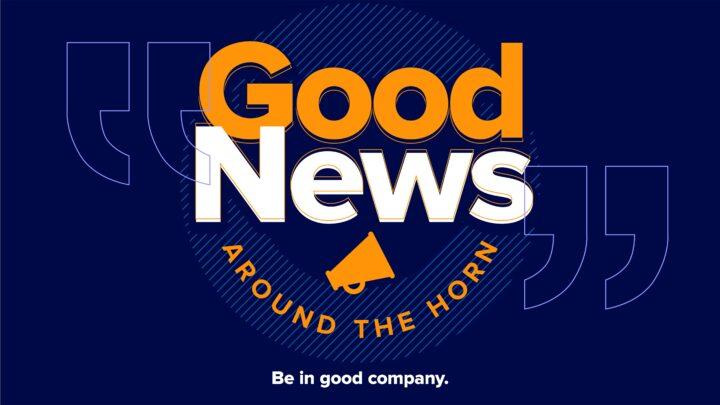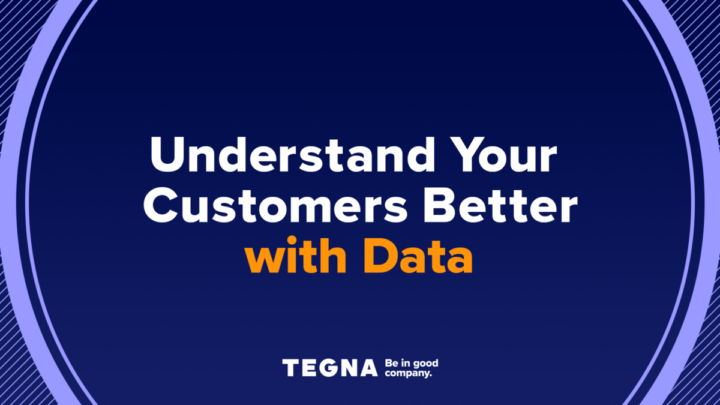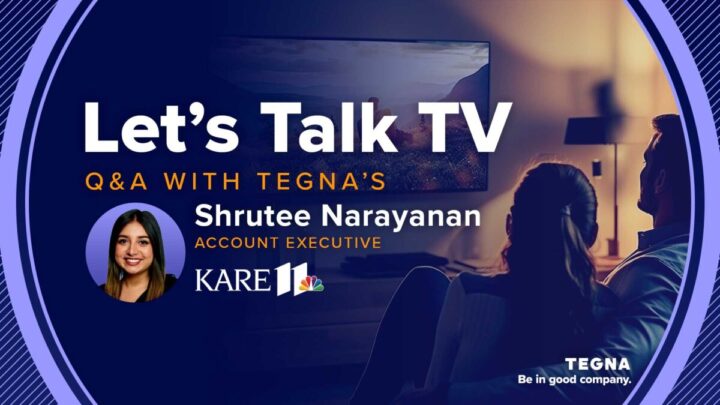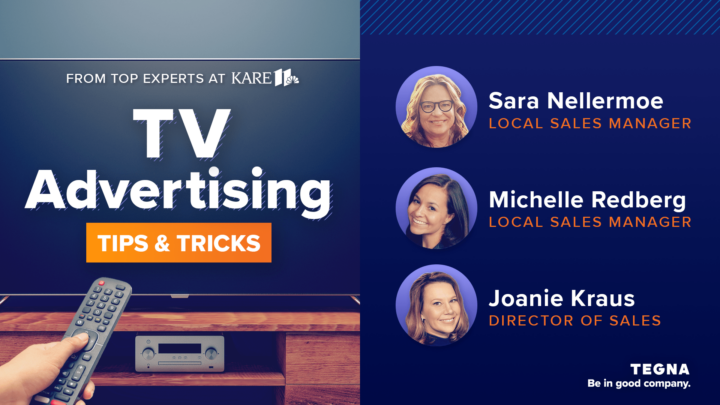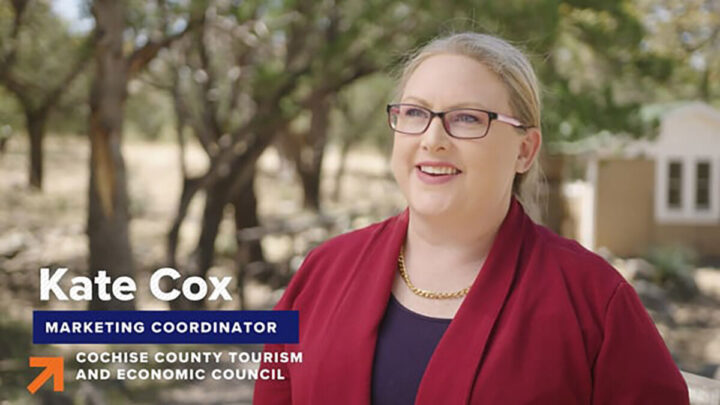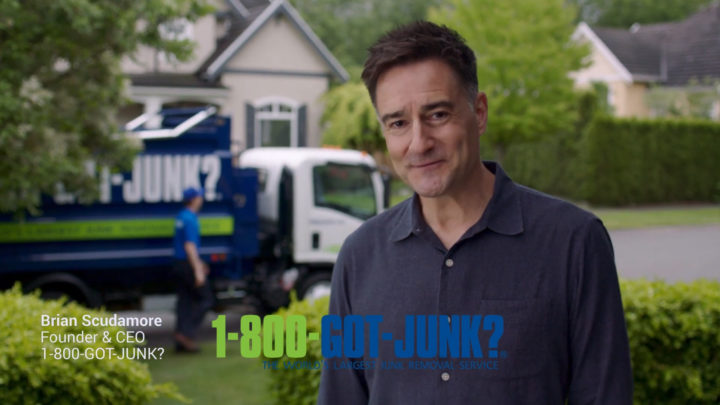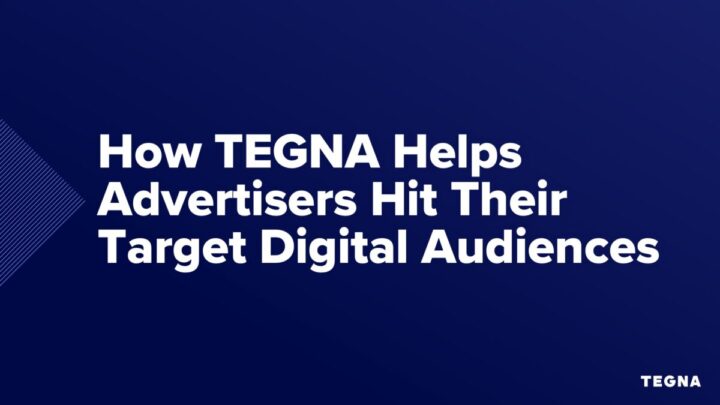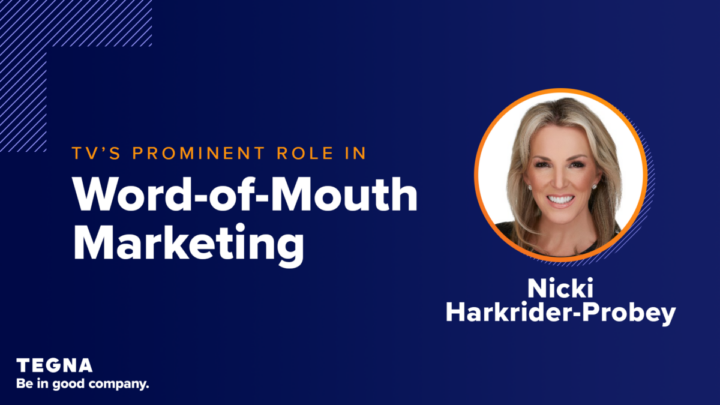What is Broadcast Advertising? The Ultimate Guide
Broadcast marketing allows advertisers to connect with a live audience while building trust in the brand. Learn more about broadcast advertising here.
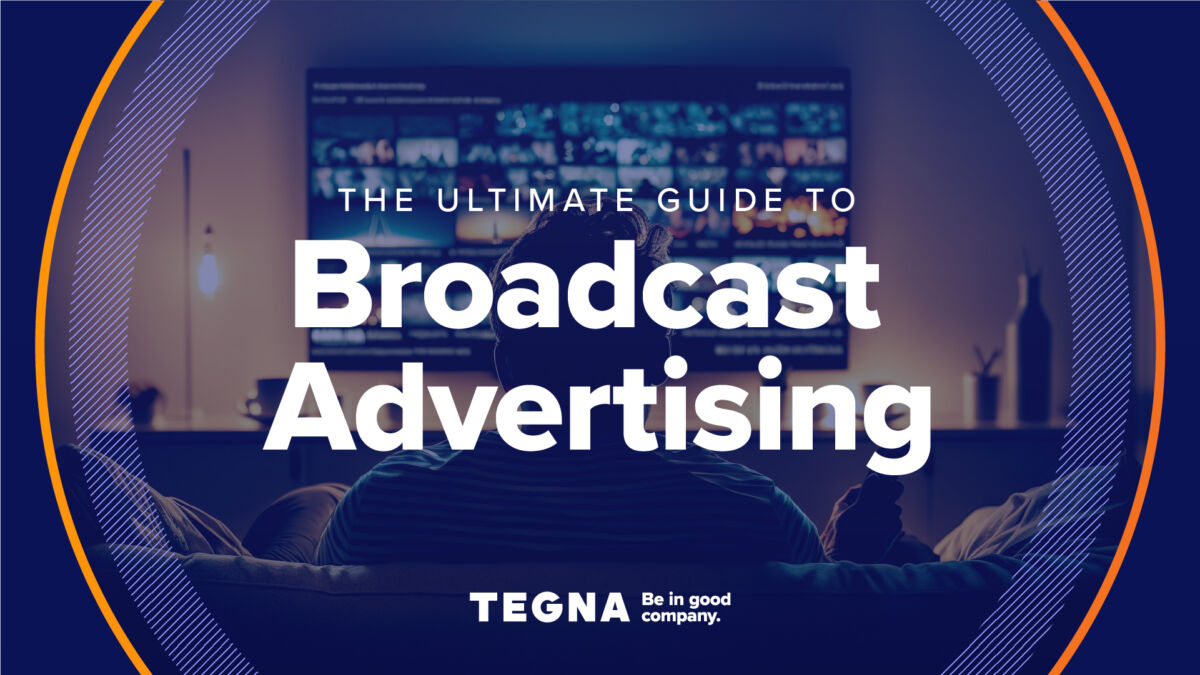
Despite the evolution of consumer viewing habits within the last decade, at TEGNA, we’ve found that broadcast television, in terms of marketing and advertising, continues to create product awareness and drive enough interest to kick-start a consumer’s journey to purchase.
And the numbers back it up. TVB’s 2023 Media Comparisons Study found that consumers credit TV ads as the most influential medium in purchasing decisions (23.6%). That’s more than double that of the second-ranked medium, social media, at 17.1.8%.
To top things off, broadcast television still accounts for nearly ¼ of media consumption among US viewers — and is the ultimate destination for viewers who seek trusted, high-quality local news, lifestyle, and local interest programming.
How can your brand get started with broadcast advertising? Our guide will help answer some of the most frequently asked questions.
What is Broadcast Advertising?
Broadcast is a long-standing, traditional form of advertising dating back to the early 20th century, in which ads air via broadcast networks during commercial breaks. Ads are an audio/visual medium and range from 15 to 30 seconds or more and detail a company’s products or services to a broad and diverse target audience.
Since the first broadcast ad aired on TV in 1941, the medium quickly grew to become one of the best and most popular ways for companies to build brand awareness and reach potential customers. Affectionately known as the “Golden Age of TV Advertising,” businesses started investing heavily in creating television commercials to promote their products to a growing audience. With visually engaging and memorable broadcast ads, millions of brands have found ways to capture audiences’ minds, hearts, and imaginations.
Throughout its history, broadcast marketing has continually adapted to technological advancements and changing consumer habits, from the introduction of color TVs in the 1970s, the cable and satellite boom, the internet and digital revolution, and the rise of mobile and personalization. While digital marketing has gained prominence, broadcast marketing remains an essential part of the advertising mix, allowing businesses to reach large audiences and build brand awareness on a broad scale.
Broadcast Advertising Opportunities
Broadcast advertising can grow brand exposure and sell products and services in several ways on different channels. But don’t limit yourself to one medium. We’ve found that cross-channel campaigns that combine broadcast, streaming, and digital advertising produce the best results.
Television
TV advertising remains a top way to generate business, and you should always consider it when planning media. With strong creative, brands can get the phones ringing, increase website traffic, and attract visitors to a brick-and-mortar location. In the world of TV advertising, there are several types a brand can consider.
- Commercials: Visual mediums, usually 15 to 30 seconds long, that tell a brand’s story and show off its products or services to get viewers to take action.
- Product Placement: Organically integrate your brand’s products into the storyline of a TV show, movie, or other programming. It can be an effective way to showcase products to engaged audiences.
- Long-Form Advertising: Appearances on Lifestyle shows, infomercials, and product demonstrations help explain complex products or services in detail and educate audiences.
OTT Streaming Apps
Many broadcasters, such as TEGNA, are growing to meet audiences where they are. For example, TEGNA’s new generation of streaming apps offers our viewers access to the best of TEGNA, including 24/7 access to breaking live and on-demand local news, newscast replays, extended live coverage, weather, and station specials and investigations, providing another platform where brands can advertise, reaching audiences who consume content via on-demand platforms.
The Advantages of Broadcast Television for Advertising
Broadcast advertising remains an essential tool for businesses. Here are the top advantages of incorporating broadcast TV into your advertising strategy.
Trust & Credibility
Trust is crucial in today’s media landscape, and TVB found that TV viewers say local broadcast news is the platform they trust most. For advertisers, the halo effect extends to brands that advertise alongside local news, especially as consumers are more likely to trust brands that advertise alongside sources of information they trust. After all, having positive associations with trusted and well-known shows and networks can beneficially influence consumer perceptions.
Broad Audience Reach & Consistent Frequency
Whether you’re a national, regional, or local brand, broadcast advertising has broad reach and access to vast and diverse audiences and demographics you can specifically target based on the time slot and programming choices. This flexibility allows for a degree of audience segmentation. Meanwhile, consistent exposure can reinforce brand messages, increase the likelihood of brand recall, and influence purchase decisions.
Audio/Visual Medium Leads to Brand Awareness & Recall
TV ads can increase brand awareness because of the ability to showcase products and services visually and audibly. Catchy jingles, silly slogans, and effective, emotional storytelling are just a few factors that can influence consumer behavior, such as brand recall and loyalty.
Live Audience
High-profile events like the Super Bowl, Olympics, or the Grammy Awards attract massive viewership; advertisers often use these occasions to exploit this reach. Better yet, brands can leverage the excitement associated with the event to create real-time interactions and memorable brand experiences. Typically, this audience is actively engaged and won’t want to miss important moments – even the commercials, making them less likely to fast-forward through commercials.
Creating a Broadcast Advertising Campaign
Creating a successful broadcast advertising campaign requires careful planning, creativity, and a deep understanding of your target audience and marketing objectives. Here are the key steps to guide you through the process:
Understand Your Target Audience
How well do you know your target audience? Understanding your customers and target demographics will help you create a campaign that speaks to them, creates a connection, and motivates them to act. Creating persona profiles and collecting and using customer data are ways to learn about your audience’s wants, needs, and pain points.
Create a Media Plan
With so many channels for brands to reach target audiences, media planning can become quite a task for marketers, advertisers, and media planners. However, it’s essential for an effective campaign. Take the time to research and find the best media channels – Broadcast TV, Streaming, Digital – for reaching your target audience while maximizing ROI.
Get Creative!
What makes for excellent TV ad creative? How do we create an ad that stands out and brings results? Effective TV ads listen to their customers first and foremost. Then craft the creative around the story and how your product or service can help solve problems.
Set Goals
What action do you want viewers to take after viewing your TV ad? How will you define a successful campaign? You’ll want to set SMART goals (Specific, Measurable, Achievable, Realistic, and Timely), such as increasing website traffic, improving conversion rates, or generating a specific number of leads. Then, figure out which metrics to use to measure success.
Analyze Results with Attribution and Measurement
Once seen as a significant limitation, TV campaigns are now measurable! TEGNA Attribution is a tool that collects real-time data for TV shows and their accompanying ads. Then, viewership connects to outcome metrics such as website visits, app downloads, and sales conversions. Your brand can use this data to prove the value of TV/streaming schedules to drive business results.
For example, let’s say the numbers show that your ad on Tuesday mornings isn’t generating any website traffic. However, that same ad generates much traffic on the evening news on Wednesday nights. TV attribution tools allow you to make the data-driven decision to adjust dayparts and programming to develop the best results and eliminate ad dollars not producing.
Examples of Successful Broadcast Advertisements
The World’s First Broadcast TV AdIn 1941, Bulova Watches debuted the first-ever TV commercial leveraging the power of sports – it aired during a baseball game between the Brooklyn Dodgers and the Philadelphia Phillies.
Why it Works: The ad that started it all only cost $9 to run and brought a new light to advertising, as it bridged the gap between radio and TV.
The Farmer’s Dog Becomes an Instant Classic
Of the 50+ ads aired during Super Bowl LVII, USA Today’s Ad Meter crowned The Farmer’s Dog as the night’s champion. Much like Google’s emotional Loretta ad that stole the show in 2020, The Farmer’s Dog stirs emotions as we follow Bear, a chocolate lab, growing up alongside his owner, Ava, from her childhood to having a child.
Why it Works: “The Farmer’s Dog scored the highest in the USA Today Ad Meter using the power of emotion instead of the power of celebrity,” says Tom Charno, Senior Consumer Insights Strategist at TEGNA. “It shows consumers respond more to brands that try to connect through poignant storytelling instead of flashy cameos.”
Penn Dixie Monster Uses Fun Creative to Create Memorable Ads
Giving credence to the fact that all industries can benefit from TV advertising, this creative from Penn Dixie Fossil Park and Nature Reserve, produced by TEGNA’s WGRZ, shows there’s nothing wrong with using humor to increase brand awareness and recall.
Why it Works: Penn Dixie Fossil Park and Nature Reserve partnered with its local news station – WGRZ – to use one of the most effective ways to sell a product: humor. Not only did the spot bring smiles to the faces of its viewers, but the brand was also able to benefit from that trust factor and halo effect that local news provides.
Partner with TEGNA for your Broadcast Advertising Campaign
At TEGNA, our ultimate goal is to equip brands with data and insights to inform creative and then amplify those messages with cross-platform campaigns, including linear, streaming, and digital elements. With 64 broadcast stations in 51 markets nationwide, our unique content opportunities will connect your business to the audiences that matter most and deliver proven results. Let’s get in touch to see how we can help your brand grow with the power of TV advertising.
Frequently Asked Questions
What Challenges Exist for Broadcast Advertising?
Broadcast advertisers face several challenges, including competition on digital channels. Audiences can also be easily distracted or tune out ads, especially if they aren’t relevant to their wants and needs. This makes it critical for marketers and advertisers to do their homework to learn about their ideal customers and create creative messages that capture attention, resonate, delight, entertain, and spark action.
How Do You Create a Television Commercial?
Knowing the target audience is vital. Do your homework to learn the problems your product or service helps audiences solve. Partnering with your local broadcast news station can help with the research, ideation, production, editing, and airing of your ad once you have an idea you’re ready to bring to life.
Despite the evolution of consumer viewing habits within the last decade, at TEGNA, we’ve found that broadcast television, in terms of marketing and advertising, continues to create product awareness and drive enough interest to kick-start a consumer’s journey to purchase.
And the numbers back it up. TVB’s 2023 Media Comparisons Study found that consumers credit TV ads as the most influential medium in purchasing decisions (23.6%). That’s more than double that of the second-ranked medium, social media, at 17.1.8%.
To top things off, broadcast television still accounts for nearly ¼ of media consumption among US viewers — and is the ultimate destination for viewers who seek trusted, high-quality local news, lifestyle, and local interest programming.
How can your brand get started with broadcast advertising? Our guide will help answer some of the most frequently asked questions.
What is Broadcast Advertising?
Broadcast is a long-standing, traditional form of advertising dating back to the early 20th century, in which ads air via broadcast networks during commercial breaks. Ads are an audio/visual medium and range from 15 to 30 seconds or more and detail a company’s products or services to a broad and diverse target audience.
Since the first broadcast ad aired on TV in 1941, the medium quickly grew to become one of the best and most popular ways for companies to build brand awareness and reach potential customers. Affectionately known as the “Golden Age of TV Advertising,” businesses started investing heavily in creating television commercials to promote their products to a growing audience. With visually engaging and memorable broadcast ads, millions of brands have found ways to capture audiences’ minds, hearts, and imaginations.
Throughout its history, broadcast marketing has continually adapted to technological advancements and changing consumer habits, from the introduction of color TVs in the 1970s, the cable and satellite boom, the internet and digital revolution, and the rise of mobile and personalization. While digital marketing has gained prominence, broadcast marketing remains an essential part of the advertising mix, allowing businesses to reach large audiences and build brand awareness on a broad scale.
Broadcast Advertising Opportunities
Broadcast advertising can grow brand exposure and sell products and services in several ways on different channels. But don’t limit yourself to one medium. We’ve found that cross-channel campaigns that combine broadcast, streaming, and digital advertising produce the best results.
Television
TV advertising remains a top way to generate business, and you should always consider it when planning media. With strong creative, brands can get the phones ringing, increase website traffic, and attract visitors to a brick-and-mortar location. In the world of TV advertising, there are several types a brand can consider.
- Commercials: Visual mediums, usually 15 to 30 seconds long, that tell a brand’s story and show off its products or services to get viewers to take action.
- Product Placement: Organically integrate your brand’s products into the storyline of a TV show, movie, or other programming. It can be an effective way to showcase products to engaged audiences.
- Long-Form Advertising: Appearances on Lifestyle shows, infomercials, and product demonstrations help explain complex products or services in detail and educate audiences.
OTT Streaming Apps
Many broadcasters, such as TEGNA, are growing to meet audiences where they are. For example, TEGNA’s new generation of streaming apps offers our viewers access to the best of TEGNA, including 24/7 access to breaking live and on-demand local news, newscast replays, extended live coverage, weather, and station specials and investigations, providing another platform where brands can advertise, reaching audiences who consume content via on-demand platforms.
The Advantages of Broadcast Television for Advertising
Broadcast advertising remains an essential tool for businesses. Here are the top advantages of incorporating broadcast TV into your advertising strategy.
Trust & Credibility
Trust is crucial in today’s media landscape, and TVB found that TV viewers say local broadcast news is the platform they trust most. For advertisers, the halo effect extends to brands that advertise alongside local news, especially as consumers are more likely to trust brands that advertise alongside sources of information they trust. After all, having positive associations with trusted and well-known shows and networks can beneficially influence consumer perceptions.
Broad Audience Reach & Consistent Frequency
Whether you’re a national, regional, or local brand, broadcast advertising has broad reach and access to vast and diverse audiences and demographics you can specifically target based on the time slot and programming choices. This flexibility allows for a degree of audience segmentation. Meanwhile, consistent exposure can reinforce brand messages, increase the likelihood of brand recall, and influence purchase decisions.
Audio/Visual Medium Leads to Brand Awareness & Recall
TV ads can increase brand awareness because of the ability to showcase products and services visually and audibly. Catchy jingles, silly slogans, and effective, emotional storytelling are just a few factors that can influence consumer behavior, such as brand recall and loyalty.
Live Audience
High-profile events like the Super Bowl, Olympics, or the Grammy Awards attract massive viewership; advertisers often use these occasions to exploit this reach. Better yet, brands can leverage the excitement associated with the event to create real-time interactions and memorable brand experiences. Typically, this audience is actively engaged and won’t want to miss important moments – even the commercials, making them less likely to fast-forward through commercials.
Creating a Broadcast Advertising Campaign
Creating a successful broadcast advertising campaign requires careful planning, creativity, and a deep understanding of your target audience and marketing objectives. Here are the key steps to guide you through the process:
Understand Your Target Audience
How well do you know your target audience? Understanding your customers and target demographics will help you create a campaign that speaks to them, creates a connection, and motivates them to act. Creating persona profiles and collecting and using customer data are ways to learn about your audience’s wants, needs, and pain points.
Create a Media Plan
With so many channels for brands to reach target audiences, media planning can become quite a task for marketers, advertisers, and media planners. However, it’s essential for an effective campaign. Take the time to research and find the best media channels – Broadcast TV, Streaming, Digital – for reaching your target audience while maximizing ROI.
Get Creative!
What makes for excellent TV ad creative? How do we create an ad that stands out and brings results? Effective TV ads listen to their customers first and foremost. Then craft the creative around the story and how your product or service can help solve problems.
Set Goals
What action do you want viewers to take after viewing your TV ad? How will you define a successful campaign? You’ll want to set SMART goals (Specific, Measurable, Achievable, Realistic, and Timely), such as increasing website traffic, improving conversion rates, or generating a specific number of leads. Then, figure out which metrics to use to measure success.
Analyze Results with Attribution and Measurement
Once seen as a significant limitation, TV campaigns are now measurable! TEGNA Attribution is a tool that collects real-time data for TV shows and their accompanying ads. Then, viewership connects to outcome metrics such as website visits, app downloads, and sales conversions. Your brand can use this data to prove the value of TV/streaming schedules to drive business results.
For example, let’s say the numbers show that your ad on Tuesday mornings isn’t generating any website traffic. However, that same ad generates much traffic on the evening news on Wednesday nights. TV attribution tools allow you to make the data-driven decision to adjust dayparts and programming to develop the best results and eliminate ad dollars not producing.
Examples of Successful Broadcast Advertisements
The World’s First Broadcast TV AdIn 1941, Bulova Watches debuted the first-ever TV commercial leveraging the power of sports – it aired during a baseball game between the Brooklyn Dodgers and the Philadelphia Phillies.
Why it Works: The ad that started it all only cost $9 to run and brought a new light to advertising, as it bridged the gap between radio and TV.
The Farmer’s Dog Becomes an Instant Classic
Of the 50+ ads aired during Super Bowl LVII, USA Today’s Ad Meter crowned The Farmer’s Dog as the night’s champion. Much like Google’s emotional Loretta ad that stole the show in 2020, The Farmer’s Dog stirs emotions as we follow Bear, a chocolate lab, growing up alongside his owner, Ava, from her childhood to having a child.
Why it Works: “The Farmer’s Dog scored the highest in the USA Today Ad Meter using the power of emotion instead of the power of celebrity,” says Tom Charno, Senior Consumer Insights Strategist at TEGNA. “It shows consumers respond more to brands that try to connect through poignant storytelling instead of flashy cameos.”
Penn Dixie Monster Uses Fun Creative to Create Memorable Ads
Giving credence to the fact that all industries can benefit from TV advertising, this creative from Penn Dixie Fossil Park and Nature Reserve, produced by TEGNA’s WGRZ, shows there’s nothing wrong with using humor to increase brand awareness and recall.
Why it Works: Penn Dixie Fossil Park and Nature Reserve partnered with its local news station – WGRZ – to use one of the most effective ways to sell a product: humor. Not only did the spot bring smiles to the faces of its viewers, but the brand was also able to benefit from that trust factor and halo effect that local news provides.
Partner with TEGNA for your Broadcast Advertising Campaign
At TEGNA, our ultimate goal is to equip brands with data and insights to inform creative and then amplify those messages with cross-platform campaigns, including linear, streaming, and digital elements. With 64 broadcast stations in 51 markets nationwide, our unique content opportunities will connect your business to the audiences that matter most and deliver proven results. Let’s get in touch to see how we can help your brand grow with the power of TV advertising.
Frequently Asked Questions
What Challenges Exist for Broadcast Advertising?
Broadcast advertisers face several challenges, including competition on digital channels. Audiences can also be easily distracted or tune out ads, especially if they aren’t relevant to their wants and needs. This makes it critical for marketers and advertisers to do their homework to learn about their ideal customers and create creative messages that capture attention, resonate, delight, entertain, and spark action.
How Do You Create a Television Commercial?
Knowing the target audience is vital. Do your homework to learn the problems your product or service helps audiences solve. Partnering with your local broadcast news station can help with the research, ideation, production, editing, and airing of your ad once you have an idea you’re ready to bring to life.

